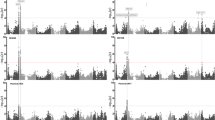Abstract
Soluble solids comprise most of onion bulb dry mass, and dehydrator onion cultivars are developed from breeding populations that have high dry mass content. Realized and narrow-sense heritability estimates were obtained for the soluble solids content (SSC) trait in two open-pollinated dehydrator onion breeding populations (BP) using response to selection and half-sib family analysis. Parental populations, designated as BP9335-U and BP9243-U, were derived from two-way crosses of lines advanced as open- pollinated (OP) populations to the F7 or F_6 generation, respectively. BP9335-U had one previous selection cycle for increased SSC and BP9243-U had three SSC selection cycles. In these experiments, parental populations were screened again for high SSC, and selected bulbs were intermated to form half-sib progeny groups, designated as BP9335-S and BP9243-S. Mean SSC was increased by 6.6% and a realized heritability estimate of 0.64 was obtained for BP9335-S. Mean SSC was increased by 6.3% and a realized heritability estimate of 0.36 was obtained for BP9243-S. Narrow-sense heritability estimates of 0.58 ±0.05 and 0.30 ±0.03 were obtained for parental populations BP9335-U and BP9243-U, respectively. Narrow-sense heritability estimates of 0.40 ± 0.03 and 0.63 ± 0.23 were obtained for progeny populations derived from selected high-SSC bulbs of these lines (BP9335-S and BP9243-S), respectively, indicating that there is significant additive genetic control of the SSC trait in these populations. Significant differences in half-sib family performance in the advanced groups BP9335-S and BP9243-S demonstrate that progeny testing was effective for evaluating phenotypic selections.
Similar content being viewed by others
References
Amer. Dehydrated Onion & Garlic Assoc., 1993. Industry Report. ADOGA, 1 Maritime Plaza, San Francisco, California 94111.
Amer. Spice Trace Assoc., 1993. Proceedings of the Fifth Annual Spice Tech Forum. ASTA, 560 Sylvan Ave., Englewood Cliffs, New Jersey 07632.
Bailey, A.L. & J.N. Corgan, 1986. Growing onions in New Mexico. Coop Ext Serv Circ 524, NMSU, Las Cruces, N.M. 88003.
Birth, G.S. & G.G. Dull, 1985. Non-destructive spectrophotometric determination of dry matter in onions. J Amer Soc Hort Sci 110: 297–303.
Cairns, A.J., 1993. Evidence for the de novo synthesis of fructan by enzymes from higher plants: a reappraisal of the SST/FFT model. New Phytol 123: 15–24.
Corgan, J.N. & N. Kedar, 1990. Onion cultivation in subtropical climates. Chap. 2. In: J.L. Brewster & H.D. Rabinowitch (Eds), Onions & Allied Crops, Ch. 2, Vol. 2, pp. 31–48. CRC Press, Boca Raton, Fl.
Darbyshire, B. & R.J. Henry, 1978. The distribution of fructans in onions. New Phytol 81: 29–34.
Darbyshire, B. & R.J. Henry, 1979. The association of fructans with high percentage dry weight in onion cultivars suitable for dehydrating. J Sci Food Agric 30: 1035–1038.
Darbyshire, B. & R.J. Henry, 1981. Differences in fructan content and synthesis in some Allium species. New Phytol 87: 249–256.
Darbyshire, B. & B.T. Steer, 1990. Carbohydrate biochemistry. In: J.L. Brewster & H.D. Rabinowitch (Eds), Onions & Allied Crops, Ch. 2, Vol. 3, pp. 1–16. CRC Press, Boca Raton, Fl.
Dowker, B.D., 1990. Onion breeding. In: J.L. Brewster & H.D. Rabinowitch (Eds), Onions & Allied Crops, Ch. 11, Vol. 1, pp. 215–232. CRC Press, Boca Raton, Fl.
Endlemann, J. & T.G. Jefford, 1968. The mechanisms of fructosan metabolism in higher plants as exemplified by Helianthus tuberosus. New Phytol 67: 517–531.
Falconer, D.S., 1981. Introduction to Quantitative Genetics. 2nd edition. John Wiley & Sons, New York, New York.
Fenwick, R.G. & A.B. Hanley, 1990. Processing of Alliums: use in food manufacture. In: J.L. Brewster & H.D. Rabinowitch (Eds), Onions & Allied Crops, Ch. 4, Vol. 3, pp. 73–91. CRC Press, Boca Raton, Fl.
Hallauer, A.R. & J.B. Miranda Fo, 1988. Quantitative Genetics in Maize Breeding, 2nd edition. Iowa State University Press, Ames, Iowa.
Havey, M.J. & W.M. Randle, 1996. Combining abilities for yield and bulb quality among long-and intermediate-day openpollinated onion populations. J Amer Soc Hort Sci 121: 604–608.
Henry, R.J. & B. Darbyshire, 1979. Sucrose: sucrose fructosyltransferase and fructan: fructan fructosyltransferase from Allium cepa. Phytochem 19: 1017–1020.
Kadams, A.M. & C.C. Nwasike, 1986. Heritability and correlation studies on some vegetative traits in Nigerian local white onion, Allium cepa L. Plant Breeding 97: 232–236.
Kehr, A.E., 1952. Soluble solids and their determination in onions. Proc Assoc Southern Ag Workers 49: 110.
Lin, M.-W., J.F. Watson & J.R. Baggett, 1995. Inheritance of soluble solids and pyruvic acid content of bulb onions. J Amer Soc Hort Sci 120: 119–122.
Madalageri, B.B., K.M. Bojappa, U.V. Sulladmath & N.M. Patil, 1986. Onion breeding for higher solids I. — Genetic variation, heritability and stability. Indian J Horticult 43: 248–251.
Mann, L.K., & B.J. Hoyle, 1945. Use of the refractometer for selecting onion bulbs high in dry matter for breeding. Proc Am Soc Hort Sci 46: 285–292.
McCollum, G.D., 1968. Heritability and genetic correlation of soluble solids, bulb size and shape in white sweet Spanish onion. Can J Genet Cytol 10: 508–514.
Nieuwhof, M., J.W. de Bruyn & F. Garretsen, 1973. Methods to determine solidity and dry matter content of onions (Allium cepa L). Euphytica 22: 39–47.
Pike, L.M., 1986. Onion breeding. Chap. 10. In: M.J. Basset (Ed), Breeding Vegetable Crops, Ch. 10, pp. 357–394. AVI Publishing. Westport, Conn.
Simmonds, N.W., 1979. Principles of Crop Improvement. Longman Publishing, New York, NY.
Simon, P.W., 1995. Genetic analysis of pungency and soluble solids in long-storage onions. J Amer Soc Hort Sci 120: 119–122.
Sinclair, P.J., A.B. Blakeney & E.W.R. Barlow, 1995. Relationships between bulb dry matter content, soluble solids concentration and non-structural carbohydrate composition in the onion (Allium cepa). J Sci Food Agric 69: 203–209.
Author information
Authors and Affiliations
Rights and permissions
About this article
Cite this article
Wall, A.D., Corgan, J.N. Heritability estimates and progeny testing of phenotypic selections for soluble solids content in dehydrator onion. Euphytica 106, 7–13 (1999). https://doi.org/10.1023/A:1003451231189
Issue Date:
DOI: https://doi.org/10.1023/A:1003451231189




